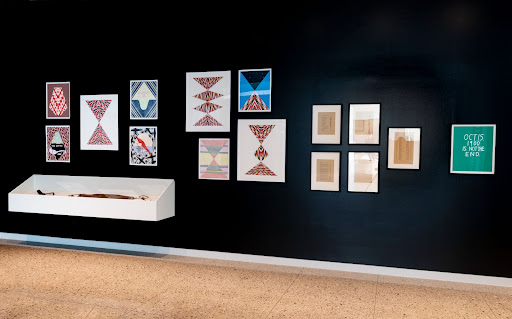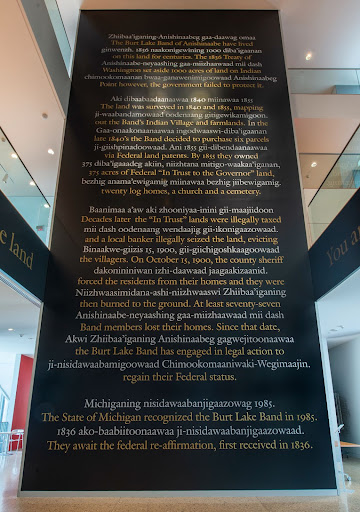Projects
Andrea Carlson Asanjigowin (Future Cache) Exhibit at UMMA

Biindigen (Welcome)
Omaa dash giwaabandaanaawaa, Andrea Carlson aabajitood ikidowinan mashkawising, zhizoobii’ang ge niigaan-inaabandang iidog, gaye gegoon asanjigaadeg wii-nisidawaabanjigaadeg ezhi-odaapinigaadeg Anishinaabewakiin gaye ezhi-inawenindiwaad gakina Anishinaabeg memindage zhiibendamowaad niigaan-nakeyaa daa-mino-izhiwebiziwaad gomaapii.
Asanjigowin dash izhi-waabanjigaadewan gaa-ezhi-maadaama’aawaad Zhaabo’iganing Anishinaaben zhaawanong Baawitig-akiing Binaakwe-giizis, 15, 1900 ishkwaa dakoniwewinini miinawaa onabiwinini gii-jaagaakizamowaad Zhaabo’igan-akiing. Ogii-inaajimowag dibendamowaad oodena wenjibawaad Zhaabo’iganing Anishinaaben. Noongom ezhinikaadeg Burt Zaaga’igan miinawaa Mishigami Gichigabegikendaasowigamig naagaanizijig dibendamowaad ji-naanaagadawaabandamowaad aki, nibi, noodin gaye ozaagakiig. Niswi-daso michisag ezhi-epiitaag izhi-ozhibii’igaadeg gaa-ezhi-giichigonigoowaad Anishinaabebii’igaadeg gaye Zhaaganaashibii’igaadeg.
Ikidowinan ishpiming atenoon izhi-nisidawendamowaad Anishinaabeg: “Gidayaa Anishinaabewakiing.” Geget, gegaa miziwe Gichigaming (gaye gakina U-M gichigabegikendaasowigamigoon, gaye o’o izhi-ganawendaagwag gaazheninjigaadeg) ateg Anishinaabewakiing. Daa-nisidawendaagwad dash geyaabi ayaawaad omaa ge dibenindizowaad Anishinaabeg misawaa bwaa-dibendamowaad akiin. Asanjigowin dash izhi-nisidawendaagwad mii geget gaa-ezhiwebag gaye daa-niigaan-wiidosemidiyang iidog.
O’o gaazheninjigaadeg gaye izhi-waabanjigaadeg niizh daso debaabanjigewinan Burt Zaaga’iganing—giishpin gaawiin gaa-maji-ezhiwebasinog gaye bwaa-giichigonigoowaad Anishinaabeg. Besho atenoon zhizhoobii’igewinan gaye naagadaajimowinensan dazhindaagwag dash ezhi-asanjigowaad anaamakamigong Anishinaabeg. Dash Anishinaabe baawidejig gichi-inendaagoziwag omaa dash daa-zhaabwiitoowaad gegoo Asanjigowin-ing daa-maada’oozhaawaad waa-ayaanikoobijigejin wii-mashkawigaabawiwaad gakina niigaan-nakeyaa gaye zhiibendamowaad.
Jennifer M. Friess
Ayaanikoominodewid Genawendang Mazinaakizigewin

Gimiigwechiwiaanaanig Zhaabo’iganing Anishinaabeg, Margaret Noodin, miinawaa Richard A. Wiles, gii-wiidookoonangwaa ozhibii’amaang gaa-ezhiwebag Mishigaming; Margaret Noodin gaye Michael Zimmerman, Jr. gii-aanikanootamoonangwaa ozhibii’amaang izhi-Ganawendaanaawaan Gaazheninjigaadeg; James Horton gaye Fritz Swanson gii-ozhitoowaad ginjidabii’igan mazina’iganan; wiiji-anokiimaaganag Mishigami Gichigabegikendaasowigamig Naagadawaabandaan Akiing, Mishigami Gichigabegikendaasowigamig izhi-Ganawendaanaawaan Gaazheninjigaadeg Ezhi-gaa-Wiijiindiwaad, Mishigami Gichigabegikendaasowigamig Clements Agindaasowigamig, miinawaa Mishigami Gichigabegikendaasowigamig Clark Minjimendamowigamig.
Ji-nandagikendaan aawiwaad Zhaabo’iganing Anishinaabeg waabandamog BurtLakeBand.org miinawaa Cheboiganing (Cheboygan) History on Ojibwe.net. .
Gimiigwechiwi’aanaanig gii-gizhaadiziwaad ge izhiwebag Asanjigowin Lizzie gaye Jonathan Tisch, Erica Gervais Pappendick gaye Ted Pappendick, miinawaa Mishigami Gichigabegikendaasowigamig Gichi-ogimaa Gikenjigewin Anokiiwigamig.
Future Cache focuses on the plight of the Cheboiganing (Burt Lake) Band of Ottawa and Chippewa Indians, who were violently forced from their home on the northern tip of Michigan’s Lower Peninsula on October 15, 1900, when the county sheriff and a local landowner claiming a right to the land set fire to the Band’s village on Burt Lake—the geographical heart of their ancestral lands. The University of Michigan benefits from the tragic displacement of the Cheboiganing Band, as part of the U-M Biological Station sits on their land. The three-story vertical wall features an account of the Band’s dispossession in their own words, alternately presented in Anishinaabemowin (the language of the Band) and English.
The text running above the gallery reminds Indigenous visitors: “Gidayaa Anishinaabewakiing / You are on Anishinaabe land.” Indeed, the majority of the Great Lakes region (including all of U-M’s campuses, and this museum) comprises Anishinaabe land. This assertion of sovereignty challenges the practice of acknowledging that one occupies contested territories, while refusing to return them to their ancestral caretakers. Future Cache implicitly asks those who have benefited from the legacies of colonization to consider where they stand and where to go from here.
The installation also features two large-scale views onto Burt Lake—imaginary decolonized landscapes that nevertheless contain some remnants of the violent realities of displacement. Adjacent is a powerful assemblage of paintings and poems that evokes the Anishinaabe practice of using underground caches to store supplies through the seasons. Centering the experience of Indigenous visitors, Future Cache is meant to foster a sense of belonging and self-determination that will allow subsequent generations to thrive.
Jennifer M. Friess
Associate Curator of Photography
 Special thanks to the Cheboiganing (Burt Lake) Band of Ottawa and Chippewa Indians, Margaret Noodin, and Richard A. Wiles, for their consultation on the State Historical Marker text; to Margaret Noodin and Michael Zimmerman, Jr. for translating the gallery texts into Anishinaabemowin; to James Horton and Fritz Swanson for generously producing the letterpress broadsides; to colleagues at the U-M Biological Station, U-M Museum of Anthropological Archaeology, U-M Clements Library, and U-M Clark Map Library. For more information on the Cheboiganing (Burt Lake) Band of Ottawa and Chippewa Indians visit BurtLakeBand.org and Cheboiganing (Cheboygan) History on Ojibwe.net.
Special thanks to the Cheboiganing (Burt Lake) Band of Ottawa and Chippewa Indians, Margaret Noodin, and Richard A. Wiles, for their consultation on the State Historical Marker text; to Margaret Noodin and Michael Zimmerman, Jr. for translating the gallery texts into Anishinaabemowin; to James Horton and Fritz Swanson for generously producing the letterpress broadsides; to colleagues at the U-M Biological Station, U-M Museum of Anthropological Archaeology, U-M Clements Library, and U-M Clark Map Library. For more information on the Cheboiganing (Burt Lake) Band of Ottawa and Chippewa Indians visit BurtLakeBand.org and Cheboiganing (Cheboygan) History on Ojibwe.net.
Lead support for Future Cache is provided by Lizzie and Jonathan Tisch, Erica Gervais Pappendick and Ted Pappendick, and the U-M Office of the Provost.
(Maaminonendan) Explore the Exhibit





